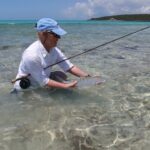Saltwater Fly Fishing 101: Techniques and Tips
Saltwater fly fishing is an exhilarating experience that offers anglers the chance to test their skills against some of the most challenging fish species found in the world’s oceans. This style of fishing requires a different set of techniques and gear than freshwater fly fishing, and it can take some time to master the art of casting a fly in the saltwater environment. In this article, we’ll cover some of the basic techniques and tips that will help you get started with saltwater fly fishing and increase your chances of success on the water.
Choosing the Right Gear
The first step in saltwater fly fishing is choosing the right gear for the job. Unlike freshwater fly fishing, where light rods and lines are often used, saltwater fly fishing requires heavier and more durable equipment that can handle the larger fish and harsher conditions of the ocean environment. Here are some of the key pieces of gear to consider:
- Rod: A saltwater fly rod should be at least 8-9 feet long and have a weight rating of 7-10. This will provide the necessary backbone and power to cast large flies and handle the strong, fast-running fish commonly found in saltwater.
- Reel: A saltwater fly reel should be strong and durable, with a large arbor to hold plenty of backing line. Look for a reel with a sealed drag system to prevent saltwater corrosion and ensure smooth operation.
- Line: Saltwater fly line is heavier and thicker than freshwater line, with a weight rating that matches the rod. A weight-forward line is usually preferred for saltwater fly fishing, as it provides greater casting distance and accuracy.
- Flies: Saltwater flies are typically larger and more colorful than freshwater flies, mimicking the baitfish and crustaceans that saltwater fish feed on. Common saltwater fly patterns include Clouser Minnows, Deceivers, and Popper Flies.
Casting Techniques
Casting a fly in saltwater can be more challenging than casting in freshwater, due to the heavier gear and often windy conditions. However, with the right technique and practice, it can become second nature. Here are some tips to help you master your saltwater fly casting:
- Double Haul: The double haul is a casting technique that uses both the rod hand and the line hand to generate more speed and power in the cast. This is essential for casting larger flies and overcoming wind resistance.
- False Casting: False casting involves casting the line back and forth in the air without allowing the fly to touch the water. This allows you to adjust your casting distance and aim before making the final delivery cast.
- Roll Casting: Roll casting is a technique used when there is not enough room behind you to make a full backcast. It involves bringing the line back over your shoulder and then rolling it forward, using the momentum of the water to make the cast.
- Shooting Line: Shooting line involves releasing extra line during the final delivery cast, allowing the fly to travel further and faster towards the target. To shoot line, release the line from your line hand while simultaneously pulling the rod back with your rod hand.
Fishing Techniques
Once you’ve mastered your casting technique, it’s time to focus on fishing the fly. Saltwater fly fishing requires a different approach than freshwater fishing, as the fish species are larger, faster, and more aggressive. Here are some tips to help you catch more fish while saltwater fly fishing:
- Retrieve: The retrieve is the way you bring the fly back to you after the cast. In saltwater fly fishing, the retrieve is usually fast and erratic, mimicking the behavior of fleeing baitfish. Vary your retrieve speed and pattern to find out what works best for the fish species you’re targeting.
- Stripping: Stripping involves pulling the line back with your line hand while keeping the rod tip pointed at the fly. This creates a jerking motion in the fly, which can trigger a strike from a hungry fish.
- Sight Fishing: Sight fishing is the practice of spotting fish in the water and casting to them directly. This is a common technique used in saltwater fly fishing, as many species of saltwater fish are visible near the surface of the water.
- Chumming: Chumming involves throwing small bits of baitfish or other fish food into the water to attract fish. This can be an effective technique for bringing fish within casting range and triggering a strike.
- Timing: Timing is an important factor in saltwater fly fishing, as many saltwater fish species feed more actively during certain times of the day or tide. Do some research on the feeding habits of the fish you’re targeting and plan your fishing trip accordingly.
Safety Considerations
Saltwater fly fishing can be a thrilling and rewarding experience, but it also comes with some risks and safety considerations. Here are some tips to help you stay safe while saltwater fly fishing:
- Wear appropriate clothing: The sun and saltwater can be harsh on your skin, so it’s important to wear protective clothing like long-sleeved shirts, hats, and sunglasses.
- Use sunscreen: Apply sunscreen regularly to protect your skin from the sun’s harmful rays.
- Be aware of your surroundings: Saltwater fly fishing often involves fishing from boats or in deep water, so it’s important to be aware of your surroundings and potential hazards like waves, currents, and rocks.
- Use caution when handling fish: Many saltwater fish species have sharp teeth or spines, so it’s important to handle them carefully to avoid injury.
- Follow fishing regulations: Make sure you are familiar with local fishing regulations and guidelines, including size and bag limits, catch-and-release practices, and protected species.
Conclusion
Saltwater fly fishing is a challenging and exciting sport that requires skill, practice, and the right gear. By choosing the right equipment, mastering your casting technique, and employing effective fishing strategies, you can increase your chances of catching some of the most exciting fish species found in the ocean. However, it’s important to always prioritize safety and follow fishing regulations to ensure a safe and sustainable fishing experience. With patience, persistence, and a love for the sport, saltwater fly fishing can be a thrilling adventure that you’ll never forget.






